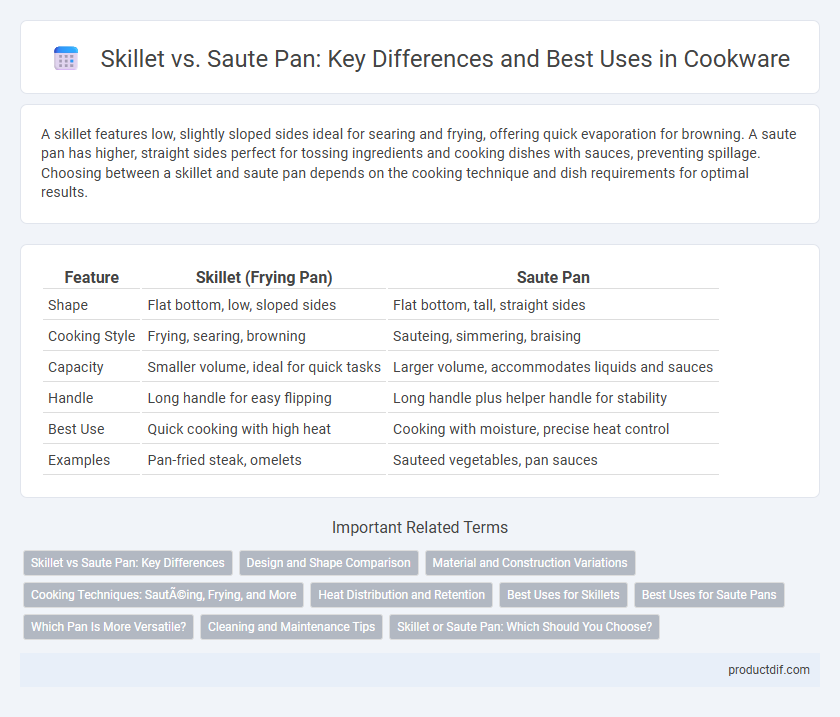A skillet features low, slightly sloped sides ideal for searing and frying, offering quick evaporation for browning. A saute pan has higher, straight sides perfect for tossing ingredients and cooking dishes with sauces, preventing spillage. Choosing between a skillet and saute pan depends on the cooking technique and dish requirements for optimal results.
Table of Comparison
| Feature | Skillet (Frying Pan) | Saute Pan |
|---|---|---|
| Shape | Flat bottom, low, sloped sides | Flat bottom, tall, straight sides |
| Cooking Style | Frying, searing, browning | Sauteing, simmering, braising |
| Capacity | Smaller volume, ideal for quick tasks | Larger volume, accommodates liquids and sauces |
| Handle | Long handle for easy flipping | Long handle plus helper handle for stability |
| Best Use | Quick cooking with high heat | Cooking with moisture, precise heat control |
| Examples | Pan-fried steak, omelets | Sauteed vegetables, pan sauces |
Skillet vs Saute Pan: Key Differences
Skillets feature low, flared sides that promote easy flipping and browning, while saute pans have deeper, straight sides ideal for containing liquids and preventing spills during stirring. Skillets excel in high-heat searing and frying, whereas saute pans are better suited for simmering sauces and cooking foods that require frequent agitation. The difference in design impacts heat distribution and cooking versatility, making skillets preferable for tasks requiring quick, direct heat and saute pans optimal for delicate, even cooking.
Design and Shape Comparison
Skillets feature a flat, wide base with gently sloped sides designed for even heat distribution and easy flipping, making them ideal for frying and searing. Saute pans have straight, tall sides and a larger cooking surface, allowing for better containment of ingredients and efficient stirring without spilling. The spatula-friendly sloped edges of skillets contrast with the high-walled shape of saute pans, which is perfect for cooking liquids and sauces.
Material and Construction Variations
Skillets typically feature sloped sides and are often made from cast iron, stainless steel, or nonstick materials, offering excellent heat retention and even cooking. Saute pans have straight sides and usually come in stainless steel, aluminum, or hard-anodized aluminum, designed for high-heat cooking and better moisture retention. Differences in construction such as multilayered or clad bases in saute pans allow for superior heat distribution compared to the usually simpler skillet design.
Cooking Techniques: Sautéing, Frying, and More
Skillets and saute pans differ significantly in their cooking techniques, with skillets ideal for frying, searing, and browning due to their shallow, sloped sides that allow quick evaporation and easy movement of food. Saute pans, featuring deeper, straight sides and a larger surface area, excel in sauteing, simmering, and reducing sauces by preventing splatter and retaining heat evenly. Both pans enhance culinary versatility, though skillets prioritize high-heat, fast cooking while saute pans support more controlled, moisture-retaining methods.
Heat Distribution and Retention
Skillets feature a wide flat base with slightly sloped sides that promote even heat distribution, ideal for searing and frying. Saute pans have a thicker, heavier base and taller straight sides that enhance heat retention and prevent temperature fluctuations, perfect for simmering and sauteing. Both pans benefit from materials like stainless steel with aluminum or copper cores for optimized thermal performance.
Best Uses for Skillets
Skillets excel in tasks requiring high-heat searing, such as frying, browning, and sauteing vegetables or meats due to their flat bottom and sloped sides that facilitate easy food flipping and quick moisture evaporation. Their design promotes even heat distribution, making them ideal for cooking delicate items like eggs or pancakes without sticking. Skillets are also versatile for one-pan meals and stove-to-oven recipes, offering efficiency and convenience in everyday cooking.
Best Uses for Saute Pans
Saute pans are ideal for cooking techniques that require even heat distribution and a large flat surface, such as searing meats, sauteing vegetables, and preparing sauces. Their high, straight sides make them perfect for tossing ingredients without spilling, as well as for shallow frying and braising. Compared to skillets, saute pans excel in handling larger volumes of food and retaining moisture during cooking.
Which Pan Is More Versatile?
A skillet features sloped sides ideal for flipping and searing, while a saute pan has straight, high sides designed for cooking with liquids and reducing splatter. The saute pan's deeper design and larger surface area make it more versatile for a wide range of cooking techniques, including browning, simmering, and frying. Home cooks often prefer the saute pan for recipes requiring both high-heat searing and saucing in a single vessel.
Cleaning and Maintenance Tips
Skillets feature sloped sides that facilitate easy wiping but require thorough cleaning to prevent food residue accumulation in corners, while saute pans with straight sides and a larger surface area demand careful scrubbing to maintain their non-stick coating. Both cookware types benefit from hand washing with warm, soapy water and avoiding abrasive materials that can damage finishes. Regular seasoning of carbon steel or cast-iron skillets enhances non-stick properties and prolongs durability, whereas stainless steel saute pans require occasional polishing to retain their shine and resist stains.
Skillet or Saute Pan: Which Should You Choose?
A skillet features sloped sides and a wide cooking surface ideal for searing and frying, while a saute pan has straight, taller sides designed for tossing and simmering with liquids. Choose a skillet for crisping and browning meats or vegetables, whereas a saute pan excels in preparing sauces and dishes requiring frequent stirring. Understanding these distinctions helps select the best cookware for specific cooking techniques and desired results.
Skillet vs Saute Pan Infographic

 productdif.com
productdif.com